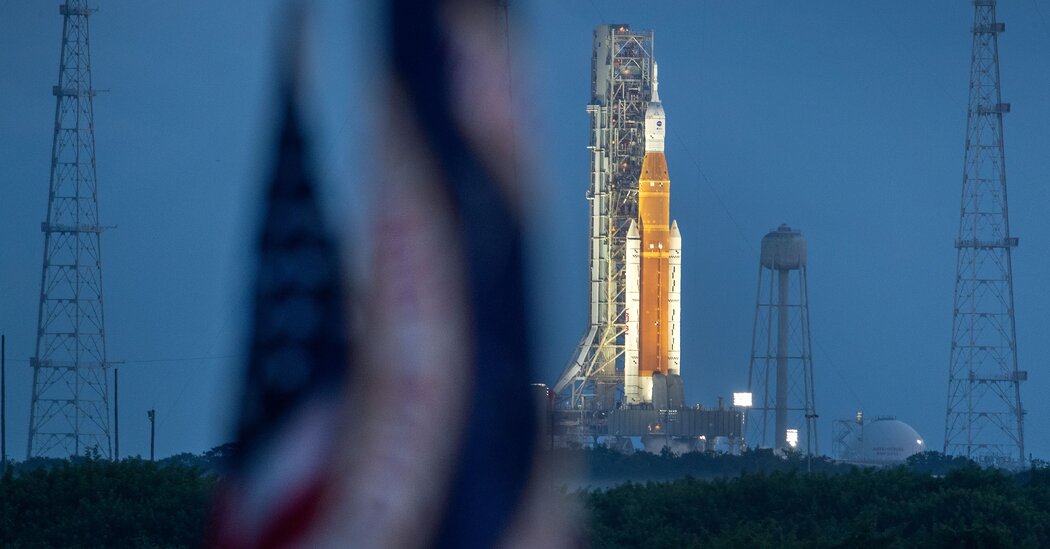NASA Scrubbed Another Moon Launch. It May Not Be the Last Time.

KENNEDY SPACE CENTER, Fla. — Before the first launch attempt of the Artemis I mission last Monday, Wayne Hale, a former program manager of NASA’s space shuttle program, shared a note of caution on Twitter that the day could end up disappointing:
Bill Harwood, a longtime space reporter at CBS News, responded, “I think you’re being optimistic!”
In the past week, their words have been prophetic. On Saturday, when NASA tried for a second time to launch the Artemis I mission’s Space Launch System rocket, a leak in a hydrogen fuel line stymied engineers. They tried several times to fix it before the launch director, Charlie Blackwell-Thompson, decided at 11:17 a.m. that it was time to scrub the day’s flight.
NASA will have to try again another day. The rocket is to propel an uncrewed Orion capsule to the moon. There are opportunities on Monday and Tuesday, but if the agency is not able to pursue them, it would have to wait until later in September or sometime in October.
Lots of launches do not get off the ground on the first try. A couple of years ago, SpaceX’s first launch of NASA astronauts — the first such launch from American soil since the retirement of NASA’s space shuttles — reached the countdown’s final minutes before the flight was delayed because of bad weather. It launched three days later.
Lots of launches do not get off the ground on the second try, either. People like Wayne, Bill and me, who were working when the space shuttles were still flying, remember many delays, including recurring hydrogen leaks like the ones that have bedeviled the first two Artemis I launch attempts.
For me, that would be the STS-127 mission, in 2009. The space shuttle Endeavour was on the launchpad on June 13 that year, ready for yet another mission to send pieces of the International Space Station to orbit.
Just like the Artemis I countdown on Saturday, there was a hydrogen leak, and the launch was scrubbed.
Hydrogen is a powerful rocket fuel. But as the smallest of molecules, it is difficult to work with, leaking through the smallest of gaps. Often, leaks do not show up until the fuel lines are chilled to ultracold temperatures of minus 423 degrees Fahrenheit, where hydrogen becomes liquid. Worse, there is no way to check except during a countdown when liquid hydrogen starts flowing into the rocket.
After the first scrub of the STS-127 mission, the Endeavour launch was rescheduled for four days later, on June 17 at 5:40 a.m. Technicians replaced the misbehaving seal.
That posed a scheduling problem for me, as a blue-ribbon panel reviewing NASA’s earlier incarnation of return-to-the-moon plans had a full-day hearing scheduled for that day in Washington.
At 9 p.m., the night before, I hopped on a plane from Newark, N.J., to Orlando, Fl., picked up my rental car and drove to the Kennedy Space Center about an hour away. Fueling of Endeavour began…
…and a hydrogen leak appeared in the exact same spot. The launch was scrubbed again at 1:55 a.m. I drove back to Orlando, flew to Washington and made it to the hearing.
“Shortest trip to Florida ever: 8 hours,” I reported to my friends on Facebook. “Next stop: D.C., where I’ll spend at least as long. Thus solving the problem of being in two places in one day without invoking quantum mechanics.”
The next launch attempt was not until July 11.
That countdown that day never even started. The evening before, thunderstorms rumbled through the area, and two strong lightning bolts hit the launchpad. NASA engineers needed a day to check that the electrical jolt had not fried any of Endeavour’s systems. (At launch time, the skies were clear and calm.)
On July 12, the countdown started, the hydrogen did not leak, yet again, the launch was scrubbed. The weather had turned bad again, with lightning near the launchpad.
Ditto for the following day.
On July 15, on Launch Attempt Number 6, Endeavour roared to the sky.
Those hanging around Central Florida through the Labor Day weekend may yet get to see the Artemis I mission take flight. NASA could go for Launch Attempt Number 3 on Monday starting at 5:12 p.m. or during a short 24-minute window beginning at 6:57 p.m. on Tuesday.
Or perhaps people will need to return weeks from now to see the giant rocket soar.
I’ll be there.
